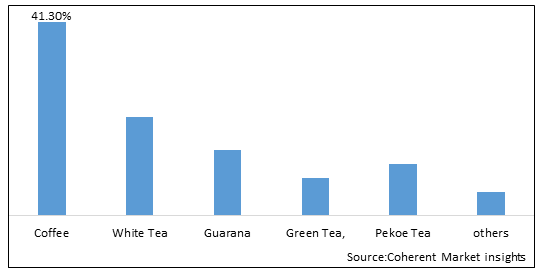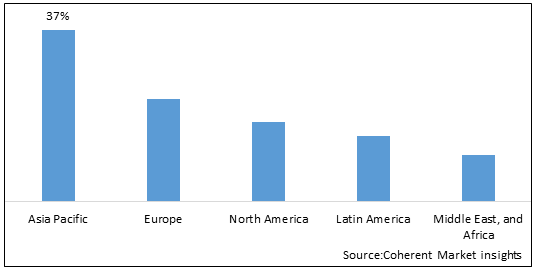Caffeine Market is estimated to be valued at USD 20.63 Bn in 2025 and is expected to reach USD 32.48 Bn in 2032, exhibiting a compound annual growth rate (CAGR) of 6.7% from 2025 to 2032.
Drivers
The growing coffee consumption globally is one of the driving factors for caffeine market growth. According to the International Coffee Organization (ICO), global coffee consumption reached 167.23 million bags in the year 2020-21, representing an average annual growth rate of 1.9% over the last year. The strongest annual growth rates have been found in Asia Pacific averaging followed by North America, Africa, and Europe According to the same source, total exports in 2020-21 amounted to 131.62 million bags, showing an increase of 9.9% compared to 2019.
Growing application of caffeine in the pharmaceutical industry is expected to drive the overall market growth. For instance, caffeine is used in a wide variety of weight loss pills to boost metabolism. Therefore, increasing demand for weight loss supplements is expected to increase the market growth. For instance, according to the Coherent Market Insights analysis report, Americans spend over US$ 2.1 billion on weight loss supplements every year.
Among regions, Asia Pacific held a dominant position in the Global Caffeine Market in 2025, accounting for 31.0% market share in terms of revenue, followed by Europe and North America. For example, cosmetic producers in the Asia Pacific region are focused on launching products using natural ingredients, which is expected to drive the demand for caffeine over the forecast period. For instance, according to Coherent Market Insights, in 2022, over 85% of the U.S. population consumed at least one caffeinated beverage per day.
Market Restraints
More consumption of caffeine causes side effects such as restlessness, insomnia, headaches, dizziness, dehydration, anxiety, etc. These side effects contributed to driving consumers to look for healthy alternatives that can replace caffeine. Some of the alternatives for caffeine are ginseng, pomegranate juice, maca, baobab, and reishi among others. The availability of such substitutes is expected to hamper the caffeine market growth.
Moreover, players operating in the food ingredients industry are focusing on developing products that can replace caffeine in food products, this is also expected to hamper the market growth of caffeine over the forecast period.
Market Opportunities
Players operating in the caffeine market are focused on developing new ingredients using caffeine for end-use industries. This is expected to drive the market growth for caffeine over the forecast period. For instance, according to L'Oreal S.A.'s quarterly report released in April 2020, in the first quarter of 2020, skincare-focused brands such as Kiehl's, Lancôme, and Helena Rubinstein outperformed the company's other premium brands. Caffeine is mostly derived from cocoa beans in personal care products. It has already achieved cult status in the Indian D2C cosmetics business, selling over ten million items. The 'world's first club,' which introduced the world's first coffee bean-shaped swimming bar in late 2020 (patent pending in India), is no stranger to the business. Demand for cosmetic chemicals such as caffeine is expected to rise as a result of skincare companies focusing on personal hygiene and cleansing products.
Caffeine Market Report Coverage
| Report Coverage | Details | ||
|---|---|---|---|
| Base Year: | 2024 | Market Size in 2025: | USD 20.63 Bn |
| Historical Data for: | 2020 To 2024 | Forecast Period: | 2025 To 2032 |
| Forecast Period 2025 to 2032 CAGR: | 6.7% | 2032 Value Projection: | USD 32.48 Bn |
| Geographies covered: |
|
||
| Segments covered: |
|
||
| Companies covered: |
BASF SE, Spectrum Chemical Manufacturing Corp., Kudos Chemie Limited, AVT Natural Products, Tianjin Zhong’an, Pharmaceutical Company Ltd., Shandong Xinhua Pharma, Aarti Industries Limited, Bakul Group, Taj Pharmaceuticals Limited., and Jilin Shulan Synthetic Pharmaceutical Co. Ltd. |
||
| Growth Drivers: |
|
||
| Restraints & Challenges: |
|
||
Uncover macros and micros vetted on 75+ parameters: Get instant access to report
Market Trends
Caffeine Anhydrous Products Are Becoming More Popular in Supplement Stores
Anhydrous caffeine is a dehydrated and processed form of caffeine that is commonly seen in powder or granular form. Caffeine anhydrous is also included in a variety of supplements, including pre-workout powders and pills.
Anhydrous caffeine has grown in popularity as a weight loss and athletic performance supplement over the years. Caffeine anhydrous allows you to consume more caffeine without ingesting big volumes of tea or coffee.
Market segment
Global Caffeine Market by Caffeine Source in 2025
On the basis of caffeine source, in 2025, the coffee segment accounted for 41.3% of the revenue share. The segment dominated the overall caffeine market in the year 2025 and is expected to continue its dominance over the forecast period. The coffee plant is a major source of caffeine. The studies by Coherent Market Insights, suggest that about 125 ml of filtered coffee and 330 ml of energy drinks contain about 85 ml and 80 mg of caffeine respectively.
Figure 1: Global Caffeine Market by Caffeine Source in 2025

To learn more about this report, Download Free Sample
Global Caffeine Market by Region in 2022
Asia pacific held dominant position in the global Caffeine Market in 2025, accounting for 37% share in terms of value, followed by Europe, North America, Latin America, and Middle East, and Africa respectively.
Figure 2: Global Caffeine Market by Region in 2025

To learn more about this report, Download Free Sample
Global Caffeine Market - Impact of Coronavirus (Covid-19) Pandemic
Caffeine is widely used as an ingredient in food & beverages, pharmaceutical, and personal care industries. Since food is an essential commodity, the demand for caffeine is expect to rise during the pandemic and post-pandemic conditions worldwide. Increased consumption of coffee-flavored personal care products is expected to increase the demand for the caffeine market during the forecast period. For instance, according to L’Oreal S.A.’s quarterly report published in April 2020, brands such as Kiehl’s, Lancôme, and Helena Rubinstein, which have a large proportion of skincare products outperformed the company’s other luxury brands in the first quarter of 2020. Thus, the skincare brands focusing on personal hygiene and cleansing products are expected to drive the demand for cosmetic ingredients such as caffeine.
Competitive Section
Key players operating in the global caffeine market include BASF SE, Spectrum Chemical Manufacturing Corp., Kudos Chemie Limited, AVT Natural Products, Tianjin Zhong’an, Pharmaceutical Company Ltd., Shandong Xinhua Pharma, Aarti Industries Limited, Bakul Group, Taj Pharmaceuticals Limited., and Jilin Shulan Synthetic Pharmaceutical Co. Ltd.
Key development
*Definition: Caffeine is a xanthine alkaloid that naturally occurs in seeds, leaves, and fruits of several plants such as coffee, tea, and guarana among others. Every day millions of people consume caffeine to alleviate fatigue, increase wakefulness, and improve concentration & focus. It is also found as an ingredient in medicines for headache and migraine.
Share
Share
About Author
Kalpesh Gharte is a senior consultant with approximately 5 years of experience in the consulting industry. Kalpesh holds an MBA in Operations and Marketing Management, providing him with a strong foundation in market strategy and analysis. He has contributed to various consulting and syndicated reports, delivering valuable insights that support informed business decisions
Missing comfort of reading report in your local language? Find your preferred language :
Transform your Strategy with Exclusive Trending Reports :
Frequently Asked Questions
Select a License Type
Joining thousands of companies around the world committed to making the Excellent Business Solutions.
View All Our Clients